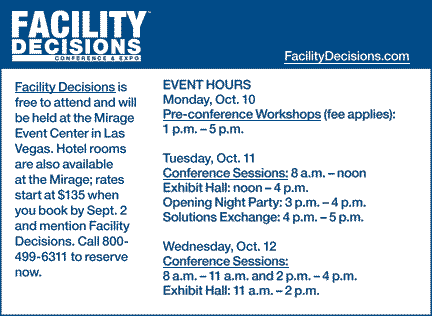Learning Curve: Tax Benefits for Energy Projects
The summer of 2011 began much like any other, with pockets of scorching temperatures affecting states throughout the Midwest and Southwest and heavy rains drenching others along the East Coast. Across the country, facility managers continued to pursue strategies that offered the most energy-efficient operation of HVAC systems, lighting, and building controls. Some facility organizations considered equipment upgrades, while others planned a retooling and recommissioning of existing systems. As usual, budget played a big factor in determining next steps.
Then two extraordinary things happened: the U.S. debt ceiling rose, and the stock market plunged. Facing an incredibly unpredictable environment, many facility operating budgets were suddenly in peril. And those energy efficiency initiatives? They were in danger, too.
They don't have to be, according to Charles Goulding, president and founder of Energy Tax Savers Inc., which specializes in advising building owners, architects, engineers and designers on tax benefits related to energy saving building investments.
Last year's updates to the Energy Policy Act (EPAct) have ushered in "a whole new category of projects qualifying for HVAC tax deductions," says Goulding, who will be presenting "Using EPAct to Make Energy Projects Possible" at next month's Facility Decisions Conference & Expo in Las Vegas.
"EPAct benefits are applicable to investments made to reduce energy use," says Goulding, adding that the current push toward LEED certification is a natural fit for EPAct tax deductions as well. "LEED buildings and EPAct integrate almost perfectly. Any time you have a LEED building, you should be thinking that you're platformed for tax savings."
Goulding points to 11 categories of HVAC equipment that now fall under EPAct's Section 179(D), noting that many of them are becoming more widely adopted throughout the facilities management marketplace and include thermal storage, demand control ventilation, chilled beam ceilings, magnetic bearing chillers and VAV devices in buildings of less than 75,000 square feet.
For facility managers who develop expertise in applying these deductions, an unbeatable opportunity to recoup upgrade investments and save energy dollars for the long haul awaits. And in a world where financial stability is a long way off, these tax savings offer a way forward for vital energy- and cost-saving projects.
Facility Decisions Pre-Conference Workshops Offer More Ways to Cut Costs
Two pre-conference workshops are available to Facility Decisions attendees on Monday, Oct. 11 from 1 p.m. — 5 p.m. The cost is $149 in advance, $249 on-site. Learn more at www.facilitydecisions.com/education
Workshop 1: Best Practices for Energy Management
Presented by Richard G. Lubinski, CEM, CDSM, CSDP, CEMSC, BEP, President, Think Energy Management LLC, and Bob Holesko, Vice President, Facilities, HEI Hotel and Resorts
Workshop 2: Measure What You Manage: How to Communicate Performance vs. Goals
Presented by Michael B. Cowley, CPMM, President, CE Maintenance Solutions
|
Related Topics:












